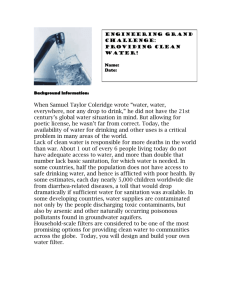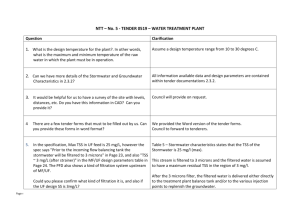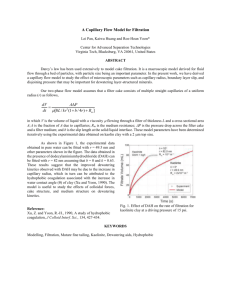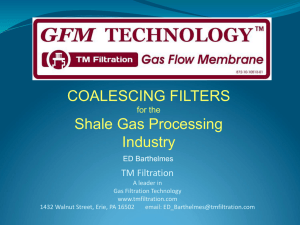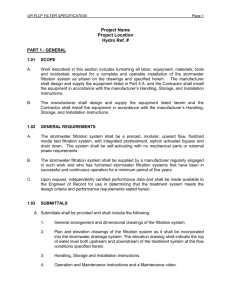X - Low Impact Development Center
advertisement
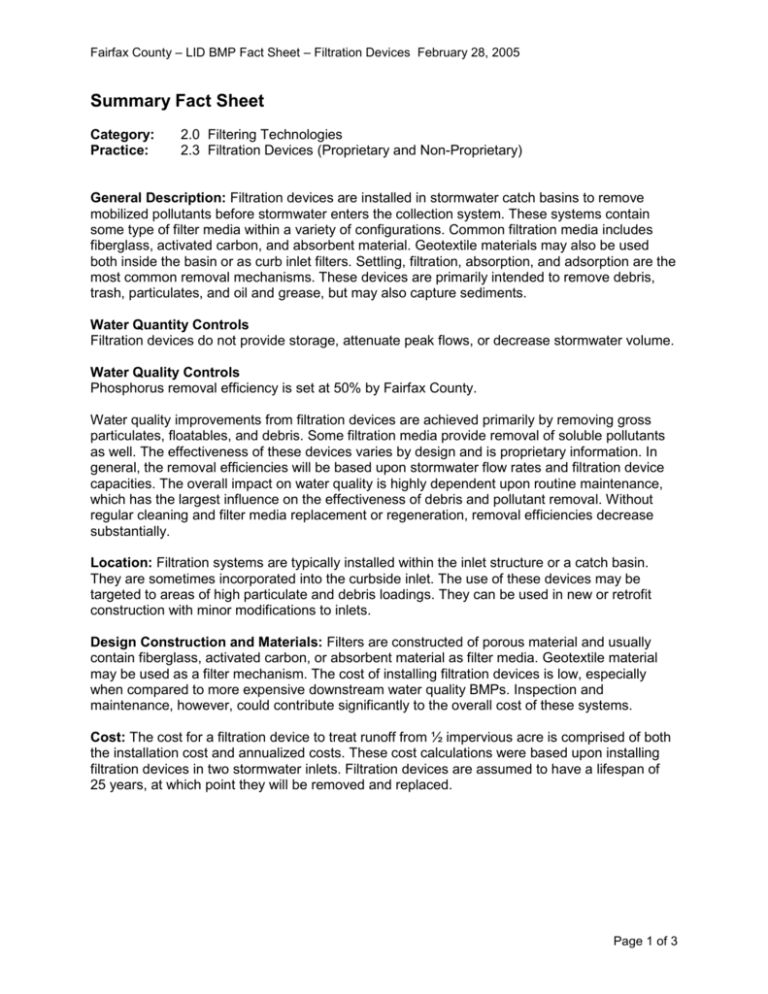
Fairfax County – LID BMP Fact Sheet – Filtration Devices February 28, 2005 Summary Fact Sheet Category: Practice: 2.0 Filtering Technologies 2.3 Filtration Devices (Proprietary and Non-Proprietary) General Description: Filtration devices are installed in stormwater catch basins to remove mobilized pollutants before stormwater enters the collection system. These systems contain some type of filter media within a variety of configurations. Common filtration media includes fiberglass, activated carbon, and absorbent material. Geotextile materials may also be used both inside the basin or as curb inlet filters. Settling, filtration, absorption, and adsorption are the most common removal mechanisms. These devices are primarily intended to remove debris, trash, particulates, and oil and grease, but may also capture sediments. Water Quantity Controls Filtration devices do not provide storage, attenuate peak flows, or decrease stormwater volume. Water Quality Controls Phosphorus removal efficiency is set at 50% by Fairfax County. Water quality improvements from filtration devices are achieved primarily by removing gross particulates, floatables, and debris. Some filtration media provide removal of soluble pollutants as well. The effectiveness of these devices varies by design and is proprietary information. In general, the removal efficiencies will be based upon stormwater flow rates and filtration device capacities. The overall impact on water quality is highly dependent upon routine maintenance, which has the largest influence on the effectiveness of debris and pollutant removal. Without regular cleaning and filter media replacement or regeneration, removal efficiencies decrease substantially. Location: Filtration systems are typically installed within the inlet structure or a catch basin. They are sometimes incorporated into the curbside inlet. The use of these devices may be targeted to areas of high particulate and debris loadings. They can be used in new or retrofit construction with minor modifications to inlets. Design Construction and Materials: Filters are constructed of porous material and usually contain fiberglass, activated carbon, or absorbent material as filter media. Geotextile material may be used as a filter mechanism. The cost of installing filtration devices is low, especially when compared to more expensive downstream water quality BMPs. Inspection and maintenance, however, could contribute significantly to the overall cost of these systems. Cost: The cost for a filtration device to treat runoff from ½ impervious acre is comprised of both the installation cost and annualized costs. These cost calculations were based upon installing filtration devices in two stormwater inlets. Filtration devices are assumed to have a lifespan of 25 years, at which point they will be removed and replaced. Page 1 of 3 Fairfax County – LID BMP Fact Sheet – Filtration Devices February 28, 2005 Item Installation1 Required Cost per Year (2005 Dollars) 0 1 2 3 4 5 6 7 8 9 10 500 500 500 500 500 500 500 500 500 500 Media Replacement 700 700 700 700 700 Remove & Replace Annualized Cost 25 8,000 Sediment and Debris Removal (every month) Total Cost … 8,000 8,000 500 1200 500 1200 500 1200 500 1200 500 1200 8,000 $1,125 / year (includes replacement in year 25) 1 Developer Cost. Not included in annualized cost. Maintenance: Maintenance is a critical component in optimizing the effectiveness of filtration devices and consists primarily of a comprehensive inspection program. Without regular cleaning and filter media replacement or regeneration, removal efficiencies decrease substantially. Studies have indicated better pollutant removal rates for systems implementing a monthly maintenance program compared to those using annual maintenance. The filter media should be replaced every two (2) years. Performance and Inspection: To ensure proper performance, visually inspect the filtration devices to ensure proper operation of the filter media. Inspections should include a determination as to whether the filter media is clogged with sediment or debris. Timely replacement of filter media is required to ensure optimum treatment performance of the filtration devices. Monthly inspections should be conducted to ensure proper operation. Signs of filtration device failure include reduced stormwater inflow rates because of constricted filtration media. Filtration Device Source: U.S. EPA Page 2 of 3 Fairfax County – LID BMP Fact Sheet – Filtration Devices February 28, 2005 Potential LEED Credits: Primary: N/A Other: Innovation & Design Process (1-4 Points) Links to Additional Information: Fairfax County PFM: http://www.co.fairfax.va.us/dpwes/publications/pfm/6.htm Virginia Stormwater Management Handbook: http://www.dcr.virginia.gov/sw/stormwat.htm#pubs Northern Virginia BMP Handbook: http://www.novaregion.org/pdf/NVBMP-Handbook.pdf Government of British Columbia, Ministry of Water, Land, and Air Protection: Water, Air, and Climate Branch: http://wlapwww.gov.bc.ca/wat/wq/nps/BMP_Compendium/Municipal/Urban_Runoff/Treatment/Filter.htm Page 3 of 3


